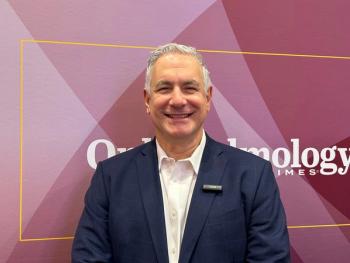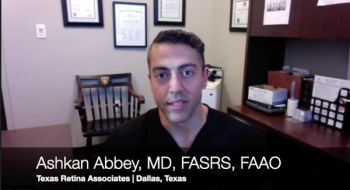
Endoscopy offers valuable adjunct in cataract surgery
Endoscopy during cataract surgery improves visualization during nearly all steps of the procedure in eyes with an opaque cornea.
Take Home
Endoscopy during cataract surgery improves visualization during nearly all steps of the procedure in eyes with an opaque cornea.
Dr. Durva Jr.
By Cheryl Guttman Krader; Reviewed by Durval Carvalho, Jr, MD
Brasília, Brazil-Endoscopy is a helpful tool for enabling safe and successful cataract surgery when operating on eyes with extreme corneal opacity, according to Durval Carvalho, Jr, MD.
While previous publications described the use of endoscopy in cataract surgery to enable capsulorhexis and IOL implantation, Dr. Carvalho said that when visualization is poor because of corneal opacity, he prefers to use endoscopy for all surgical steps, including phaco.
He terms the latter procedure “endophacoemulsification.”
“Dense corneal opacification presents a great challenge for cataract surgeons,” said Dr. Carvalho, chief, cataract department, Brasília University, and cataract and glaucoma surgery specialist, Centro Brasileiro da Visão, Brasília, Brazil. “Although use of trypan blue dye to assist capsulorhexis and endoillumination during phacoemulsification to improve visualization with the microscope can be very helpful, these techniques are not enough in cases of extreme leucoma.
“Furthermore, they do not allow surgeons to identify such complications as posterior capsule rupture, much less solve them,” he continued. “The use of endoscopy during cataract surgery requires new skills, . . . there is a learning curve for using the endoscopic probe and it affects visualization in other ways because the field of view is narrower and there is no stereoscopy. Nevertheless, it has many benefits for the surgeon and can spare patients from needing a triple procedure with keratoplasty.”
Endophacoemulsification
For endoscopy, Dr. Carvalho uses technology that was developed by Martin Uram, MD, for performing endocylophotocoagulation (Uram E2, EndoOptiks).
The endoscopic probe is introduced through a corneal side port incision to observe the instruments and intraocular structures. Once the probe is placed, the surgeon changes the microscope view to the monitor.
“The learning curve for using endoscopy during cataract surgery involves becoming adept at controlling the position of the probe, adjusting the focus, and achieving the correct distance from the intraocular structures,” Dr. Carvalho said.
Benefits of procedure
With the endoscopic probe in the eye, the surgeon can see in detail construction of the main incision.
“The exact time and location that the blade penetrates the cornea can be seen with endoscopy, and so it can become a teaching tool,” Dr. Carvalho said.
Endoscopy also enhances evaluation of the anterior chamber angle so that surgeons can better identify and avoid synechiae.
Watching the bubbles with the viscoelastic, surgeons can also determine when the viscoelastic has completely filled the anterior chamber.
With guidance from endoscopy, capsulorhexis can be performed without use of stains in eyes with a hypermature cataract lacking a red reflex. If a tear extends during capsulorhexis creation, it is easier to monitor its extension when using endoscopy compared with the microscope’s view.
“The surgeon can see a tear extending beyond the pupil, which facilitates recovery in continuous capsulotomy,” Dr. Carvalho said.
During phaco, use of endoscopy enables positioning of the phaco tip in the middle of the anterior chamber at a safe distance from the corneal endothelium and posterior capsule. It also allows verification that the nucleus was adequately grooved during sculpting and then completely divided.
Endoscopy is then used to follow the nucleus fragments as they are emulsified.
“With endoscopy, surgeons can identify lost fragments behind the iris or pieces of the nucleus that are trapped at the anterior chamber angle,” Dr. Carvalho said.
Endoscopy can also be used to watch while the IOL is implanted and to check IOL position in the capsular bag.
Dr. Carvalho noted he has used endoscopy to analyze the placement of single-piece monofocal IOLs, as well as accommodating IOLs and implants designed for sulcus implantation.
Pitfalls
However, there are a few disadvantages of endoscopy, Dr. Carvalho said.
During hydrodissection, its use does not allow surgeons to follow the cleavage wave of the posterior cortex. In addition, if the anterior chamber shallows during phaco, the surgeon will not see if the posterior capsule is coming toward the phaco tip.
“In the latter situation, the microscope can be used as a complementary tool, showing the sideways descentration,” Dr. Carvalho said. “However, once the situation is resolved, surgeons should return their attention to the endoscope monitor.”
Dr. Carvalho highlighted his use of endoscopy-assisted cataract surgery in a patient with Cogan's syndrome who had advanced corneal opacity that was mostly in the stromal layer and sparing the center.
“The conventional treatment in a case such as this would be to perform a triple procedure with keratoplasty plus cataract removal and IOL implantation,” he said. “However, with the use of endoscopy, phacoemulsification and IOL implantation were safely performed in both eyes, and the patient achieved BCVA of 20/40 in the right eye and 20/25 in the left eye while being spared from having a corneal transplant.”
Durval Carvalho, Jr, MD
Dr. Carvalho has no financial interest in the equipment he described.
Newsletter
Don’t miss out—get Ophthalmology Times updates on the latest clinical advancements and expert interviews, straight to your inbox.





















































.png)


